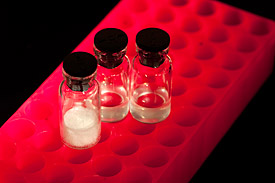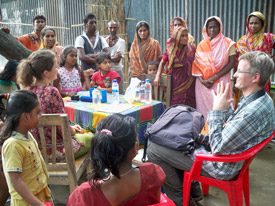October 2010
Bangladesh - Arsenic in the water
Helmholtz Centre tests new arsenic-detection kit ARSOlux in Bangladesh
Arsenic is an element that is as much a part of this planet as the air we breathe. In some parts of Europe it is called ‘mother-in-law’s poison’. However, the story of arsenic is not just a tale to be told over a drink to liven up the evening. Arsenic is an element that is endangering the lives of millions of people - lives that we scarcely hear about here in Europe.

The innovative ARSOlux biosensor measures the arsenic concentration of the drinking water.
Photo: André Künzelmann/UFZ

Microbiologist and inventor of the ARSOlux method, Prof. Hauke Harms, in the village of Nawapara in Bangladesh. In front of him is his colleague.
Photo: Carola Endes/UFZ
A major scene of these incredible events is Bangladesh. Since attaining independence in 1971, Bangladesh has, with the help of UNICEF and other organisations, sunk over 11 million wells to provide the people with clean water, including 3 million private wells. Yet there is a problem lurking in the upper soil layers here that no one was aware of at the time: arsenic, which has been accumulating here for thousands of years. Now, instead of dying of polluted surface water, people are being poisoned by groundwater. Between 35 and 77 million Bengalis are affected - the estimates vary widely. But even the lowest figure of 35 million people is staggering. There is talk of the largest wave of poisonings in human history.
Prof. Hauke Harms of the Helmholtz Centre for Environmental Research (UFZ) in Leipzig wanted to see the situation for himself. Together with an international team of researchers, he has developed a method of detecting arsenic levels in water. So he and a team from Leipzig travelled to Dhaka, the capital of Bangladesh. The trip was also the first ARSOlux biosensor project undertaken by the new team. Their aim is to market the test procedure, with plans to set up a new company in the near future. Involved in the venture are economist Sonja Hahn-Tomer, geographer Konrad Siegfried, biologist Carola Endes, microbiologist Antonis Chatzinotas and business economist Karla Rohrberg, who is in charge of the team`s accounts and media presence.
Bangladesh is a bit larger than Bavaria and Baden Württemberg together, but has a population twice the size of Germany´s - 160 million people. The government is not in a position to solve the arsenic problem on its own. International organisations like UNICEF, WHO and UNESCO will have to do something. But the country must be prepared to let them. This is another problem: arsenic poisoning is not top of the agenda here. That place is reserved for famine and environmental disasters. The land rises out of the Indian Ocean and the capital, Dhaka, is just six metres above sea level. The coastal region with its 15 million inhabitants is the most severely affected by global warming in the world, in terms of people per m². Cyclones like Cyclone Sidr, which hit Bangladesh in November 2007, are claiming more and more victims. They tend to occur in the spring and autumn in the Gulf of Bengal, flooding huge swathes of the country. Nearly a quarter of Bangladeshis are starving. They are dying before the poison can take effect.
During their trip, the team from Leipzig visited Nawapara, a village with a population of 5200, about 25 km from Dhaka. The people here live in corrugated iron huts on plots measuring 10 to 20 m². It is difficult to imagine how they survive here in the monsoon season. Each hut does have a small television set, although the pressure on the electricity grid caused by the air-conditioning units in the towns and cities results in several power cuts a day. Sixty wells were tested in this village. Nearly all of them contained arsenic. Only a few contained less than 10 micrograms per litre, the maximum level recommended by WHO. Most of them were found to contain between 200 and 300 micrograms per litre.
"I know a lot more than I did before," says Hauke Harms after a day of testing. "I am very impressed by the people. They were very friendly, not at all frustrated and keen to know the verdict on their water. It motivates me to push ahead with all this." Prof. Hauke Harms doesn’t sleep well that night. As well as the unbearable heat, he is now bothered by the villagers and their stories. Everyone here is aware of the arsenic problem. Even the smallest children know that they are supposed to filter the water, but there is often not enough money for a filter. However, most of the wells have not yet been tested. People only discover whether or not their water is laced with poison after years of drinking it. The first symptoms of arsenicosis are skin problems, which range from dark patches to serious skin damage. Then the blood vessels and organs become affected and cancer occurs, eventually leading to death.
However, the trip is not primarily a charitable one. First and foremost it is about lots of organising, about raising awareness and about money. So the next item on the agenda is a meeting to bring together the decision-makers. ARSOlux needs a market. There is a lot of interest, but the outcome is still uncertain. There appears to be no help available from the government. As Dr Salamat Khandker, a medical professional who works for WHO in Bangladesh, said over lunch, "The arsenic problem is not one we created. It’s the geological structures. It’s not our fault that our water is full of arsenic. That’s why we need help from outside. The government does not have any more resources. Anyway, we have other, more urgent, problems. The destruction of the environment, for example. The land floods regularly and everything that the people build gets washed away. Then there’s famine. Why should people be interested in arsenic in the water when they are just happy to find something to eat today to keep them alive until tomorrow?"
In Bangladesh the ARSOlux team has chosen one of the world´s most difficult markets. The team had wanted
to get an overview of the local situation and make contacts. The result is clear after just a few days: for the time being, the first target market for ARSOlux will be Europe. Here too there is arsenic in the
groundwater, and there are over 100 000 wells in Germany alone. The plan is to test the water samples at a central location and send back the results. Communication will take place primarily via an Internet platform.
"We have a long way to go to help the people in Bangladesh," says Konrad Siegfried of the UFZ, who spent the longest time in Bangladesh. "The population needs to be better informed. There are no campaigns warning
people about the poison. That would be a start. And then we need to put ourselves in their shoes. We have to learn how they think. Only then will we stand a chance of being able to help."
Annegret Faber
At the Helmholtz Centre for Environmental Research (UFZ) scientists research the causes and consequences of far-reaching environmental changes. They study water resources, biological diversity, the consequences of climate change and adaptation possibilities, environmental and biotechnologies, bio energy, the behaviour of chemicals in the environment and their effect on health, as well as modelling and social science issues. Their guiding research principle is supporting the sustainable use of natural resources and helping to secure these basic requirements of life over the long term under the influence of global change. The UFZ employs 930 people at its sites in Leipzig, Halle and Magdeburg. It is funded by the German government and by the states of Saxony and Saxony-Anhalt.
The Helmholtz Association helps solve major, pressing challenges facing society, science and the economy with top scientific achievements in six research areas: Energy, Earth and Environment, Health, Key Technologies, Structure of Matter, Transport and Space. With 28,000 employees in 15 research centres and an annual budget of around EUR 2.4 billion, the Helmholtz Association is Germany’s largest scientific organisation. Its work follows in the tradition of the great natural scientist Hermann von Helmholtz (1821-1894).
